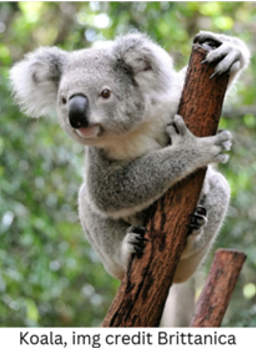Urban Legends-- The Drop Bear
- Eloise Wechsler
- Dec 3, 2024
- 4 min read
Updated: Dec 4, 2024

Australia is no stranger to odd animals. For example, the platypus is an Australian native animal so strange, scientists thought it was a hoax when it was first discovered. Animals such as the kangaroo and cassowary have also captured the world’s attention for their fantastic strangeness. Thus, stories of Australia’s bizarre wildlife have often been embellished and transformed into veritable myths. However, unlike the platypus, the drop bear is a supposed “Australian native animal” that is too strange to be true. This killer species of koala has captured the minds of Australia for decades.
Unlike many urban legends such as sewer gators (the subject of a previous Valley Times article) or Bigfoot, the drop bear isn’t a cryptid that people genuinely believe in the existence of. Rather, it’s an inside joke invented by Australians, told to tourists to frighten them or make them look silly. Many otherwise reliable institutions have played into the joke, including the Australian Museum, which features a drop bear alongside other real wildlife; Australian Geographic, which ran an April Fools’ article on drop bears; and the online Institute of Australian Culture, which also features an article in which drop bears are presented as real animals.
Despite (photoshopped) photographic evidence, extensive “research” on them, and even a scientific name (Thylarctos plummetus), there is no evidence that drop bears have ever existed. However, a somewhat similar genus of animals, the Thylacoleo genus, prowled Australia in prehistoric times. Commonly called the marsupial lion, these animals showed many similarities to the modern day legend of the drop bear. They had strong back legs and sharp premolars. They are also evolutionarily connected to the vombatiform suborder, the suborder wombats and koalas (and, by extension, drop bears) would belong to. However, despite its similarities to the wombat and koala, it was a predator and, judging by bone structures found in its arms and paws, could have hunted from the air. Due to these similarities to the drop bear, it is very probable that the modern-day myth of the drop bear was at least partially inspired by the marsupial lion.
It is unknown where the hoax itself first started. However, it is often attributed to the Paul Hogan show, an Australian comedy show. One episode parodies Indiana Jones and features vicious koalas jumping from trees to attack their victims. Other theories for the origin of this myth include it being told to soldiers coming from overseas to scare them.
This fearsome beast supposedly resembles a koala in most aspects, with one notable exception– bloodlust. It’s described by the Australian Museum as having enormous, sharp teeth and powerful legs to grab their prey. Size estimates range from that of an ordinary koala to a leopard or large dog! In case the name wasn’t enough of a tell, drop bears supposedly hunt their prey by dropping from high trees to attack their victims. These victims are mostly mammals. According to the Australian Museum, humans do not make up their preferred diets, however they may be mistaken for food and accidentally attacked (similar to shark attacks).
A major part of the legend revolves around the prevention of drop bear attacks. According to legend, drop bears detest the taste of Vegemite. Vegemite is a yeasty spread that is most popular in Australia. Its taste is a very polarizing topic, with some defending it adamantly and others, usually non-Australians, calling it disgusting. Drop bears fall (pun not intended) into the latter category. In an article published on April Fools’ Day 2021, Australian Geographic published a joke article positing that Australians were less likely to be attacked by drop bears than tourists. One explanation was given as this:
“By-products of the interaction between chemicals found in Vegemite and those found in human sweat repel drop bears,” Volker says. “Most Australians eat Vegemite at least once a day, so they permanently exude these chemicals through their skin and are thus protected.”

So how can tourists, who lack the protective chemicals bestowed upon them by vegemite, save themselves from attack? Well, by making like the locals and covering themselves in Vegemite, of course! Spreading vegemite behind one’s ears is apparently particularly effective at repelling these vicious mammals. Another way to keep them away is to wear forks in your hair, the spikes functioning to ward off any attacks from above.
Although they may be the most popular, drop bears certainly aren’t the only hoax intended to prank tourists in Australia. Another fictitious animal is often told as real– The hoop snake. This snake is supposedly native to North America, Canada, and Australia. Grabbing their tails in their jaws, these serpents roll themselves into a hoop and chase after their prey at high speeds of up to 60 km per hour. Its prey includes small animals, occasional sheep, and– of course– humans unlucky enough to be outpaced by this fearsome beast. Some versions of the story also report that it has enough venom to kill a human.
Drop bears are fictional, but the spread of misinformation online spreads far further than this humorous story. Many hoaxes can be silly, such as the drop bear or the pacific tree octopus (an online hoax dedicated to saving the endangered “pacific tree octopus”, a fictional species of cephalopod that can live both online and in the water). However, some can be far more dangerous and misleading, so it’s important to check the reliability of a source before believing what it says. Some ways you can do this are by checking the institution it comes from and double-checking that other sources say similar things.
Australian Museum. “Drop Bear.” The Australian Museum, 2021, australian.museum/learn/animals/mammals/drop-bear/. Accessed 15 Nov. 2024.
Staff, AG. “Drop Bears Target Tourists, Study Says.” Australian Geographic, Apr. 2021, www.australiangeographic.com.au/news/2021/04/drop-bears-target-tourists-study-says/. Accessed 15 Nov. 2024.
“Drop Bears: The True History of a Fake Australian Animal.” CNN, 30 July 2024, edition.cnn.com/travel/drop-bears-legend-australia-intl-hnk/index.html. Accessed 15 Nov. 2024.
ITV News. “Our Reporter Pranked into Thinking the Koala She’s Holding Is a “Deadly Drop Bear” | ITV News.” YouTube, 13 Jan. 2020, www.youtube.com/watch?v=6RzrUOCWjtw. Accessed 15 Nov. 2024.
“Mars Campers.” Mars Campers, 2024, marscampers.com.au/explore-mars-campers/hoop-snakes-the-worlds-deadliest-snake/. Accessed 16 Nov. 2024.
“Drop Bears.” The Institute of Australian Culture, 31 Mar. 2024, www.australianculture.org/drop-bears/. Accessed 18 Nov. 2024.
Dillon, Meagan. “Where Did the Urban Legend of the Dangerous Australian Drop Bear Come From?” Abc.net.au, ABC News, 17 Jan. 2020, www.abc.net.au/news/2020-01-18/where-did-the-drop-bear-myth-originate/11874020. Accessed 18 Nov. 2024.
Australian Geographic. “Where Did the Drop Bear Myth Come From?” Australian Geographic, 14 July 2021, www.australiangeographic.com.au/topics/history-culture/2021/07/where-did-the-drop-bear-myth-come-from/. Accessed 18 Nov. 2024.






Comments